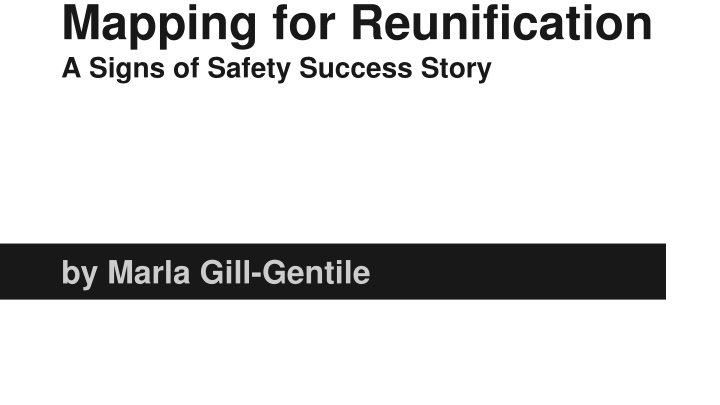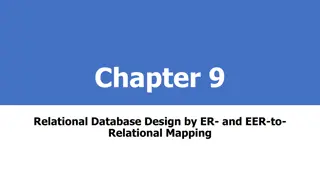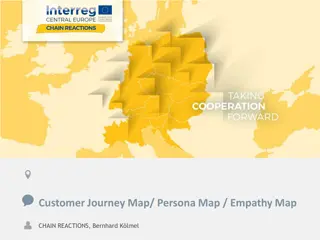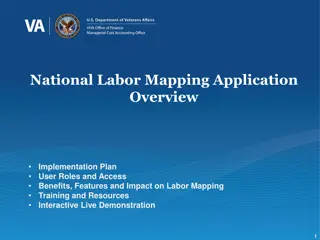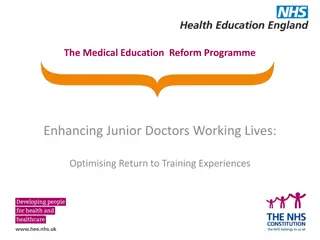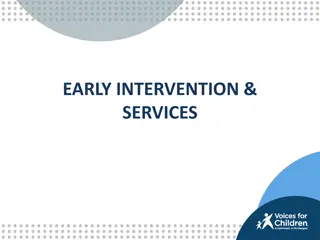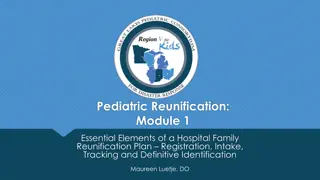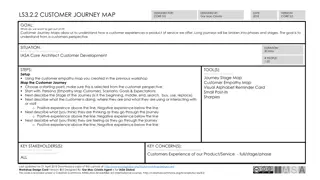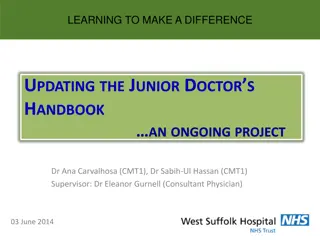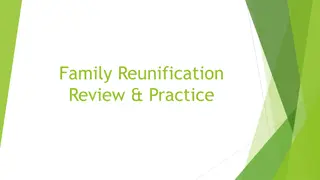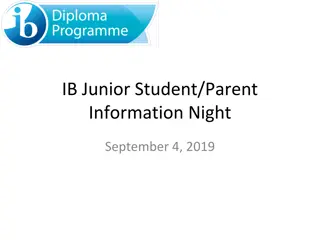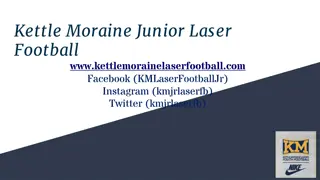A Story of Success: Mapping for Reunification - Junior's Journey
Junior's story revolves around his journey in foster care and the challenges his family faced, especially his aunt, Mrs. Smith. Despite obstacles like housing issues and anxiety, efforts were made towards reunification, showcasing resilience and determination in the face of adversity.
Download Presentation

Please find below an Image/Link to download the presentation.
The content on the website is provided AS IS for your information and personal use only. It may not be sold, licensed, or shared on other websites without obtaining consent from the author.If you encounter any issues during the download, it is possible that the publisher has removed the file from their server.
You are allowed to download the files provided on this website for personal or commercial use, subject to the condition that they are used lawfully. All files are the property of their respective owners.
The content on the website is provided AS IS for your information and personal use only. It may not be sold, licensed, or shared on other websites without obtaining consent from the author.
E N D
Presentation Transcript
Mapping for Reunification A Signs of Safety Success Story by Marla Gill-Gentile
Introduction Family Background My story is about a boy named Junior, who came into care in Calgary when he was 8 years old. I began working with Junior and his family over 3.5 years ago. When Junior came into care, it was supposed to be temporary, but now he has been living in foster care for over 4 years. The good news is that he has been at the same foster home the entire time. Band consults and feedback from the boy s aunt indicated that there was no viable kin for Junior to live with.
Family Background continued Junior s family consists of his aunt (Mrs. Smith), her boyfriend (John Doe) and his four cousins. Junior came into care due to struggles Mrs. Smith was having with his behavior. A short time later, Mrs. Smith hit rock bottom when her own children were taken into care. Mrs. Smith consented to a Permanent Guardianship Order (PGO) for Junior. Once her own children came into care, Mrs. Smith began to change her life. issues included criminal activity, substance abuse, domestic violence and neglect. addition, as a child, Mrs. Smith was a victim of physical and sexual abuse and spent some time in a residential school. Mrs. Smith was successful at completing addiction treatment, completing programs on parenting and domestic violence and working with In Home Support and other resources. To date, Mrs. Smith continues to access community resources as needed and is very insightful about various issues. Mrs. Smith s In
Family Background continued Mrs. Smith has been sober for over 2.5 years and has been in a healthy relationship for about 2 years. As soon as Mrs. Smith got her own children back and Children s Services closed their file, she began to ask what she needed to do to get her nephew back. reunification was interrupted last year by a sudden move to Medicine Hat. The aunt was asked to move from her Calgary home and then the flood occurred in June making it even more difficult to obtain housing in Calgary and then she and her family went to Medicine Hat where her partner has family. The
Family Background continued When Junior was 11 years old, he wanted to move back with his family, when they resided in Calgary. When the family moved to Medicine Hat in August 2013, the idea of reunification now caused Junior great anxiety. partly due to the family being without housing in Medicine Hat, causing them to reside at a hotel, via a shelter. This was
Family Background continued Over the last year, Junior has expressed many worries and questions about the potential move back with family. order to move forward with the case plan, Junior s worries and questions had to be addressed in a different way. Attempts by Junior s supports to speak to him individually were not working and it became evident that all parties involved needed to come together as a group to address Junior s questions and worries. In
Family Background continued Junior lived with his mom briefly and in foster care from ages 0-4 years. The aunt raised Junior from age 4-8 years and the foster mother raised Junior from age 8-12 years. Both the aunt and his foster mother have valuable information about Junior. Foster parents are definitely a part of a team and this story really speaks to how the foster mother was included in decision making and how Junior s needs were put ahead of everyone else s.
Family Background continued It should be noted that over the last two years, the foster mother had been somewhat apprehensive about Junior s move to live with his aunt again. Foster mom, Jane, moved from not even wanting to meet Mrs. Smith two years ago, to embracing the mapping process and travelling over 600 kms to Mrs. Smith s home. Jane felt strongly that Junior was better off in foster care as she did not believe Mrs. Smith could maintain stability for a sustained period of time. In spite of her reservations, the foster mother Jane continued to support Junior and partake in meetings.
Family Background continued Over the last several months, Jane and Mrs. Smith have been having regular contact over the phone, discussing concerns about Junior. This led to Junior seeing Jane and Mrs. Smith as a team and a united front. Again, in order for the case plan to work, everyone involved in Junior s life needed to come together for his best interests.
Family Background continued As the months went on, Junior processed the move directly with his aunt, her boyfriend, his foster mom, his caseworker and his therapist. Junior even pulled in the support of the Children s Advocate, to ensure that his voice was being heard. Each member of Junior s team worked with him to address his questions and re-assure him about the move. Calgary supports met with him as a group and collectively answered his questions and addressed his concerns. After this meeting, it was determined that a family mapping meeting was still needed, as important players were not in attendance at the Calgary meeting. emphasis on Junior moving away from his paid supports and moving towards his natural supports. Discussions occurred with Junior regarding foster care not providing permanency the way that his aunt and family would. On April 28th, 2014, Junior s During this time, there was a heavy
Family Background continued Junior still had questions and concerns and it was decided that a Signs of Safety Map needed to be completed with all of Junior s supports present in one place. Due to the aunt living in Medicine Hat, not having a vehicle and having a four month old baby, it was decided that a road trip to her home was necessary. It took some time to arrange the long distance meeting and as time went on Junior began to slowly embrace the plan to move back to his aunt s.
Family Background continued When the mapping meeting occurred on May 12th, 2014 at the family s home in Medicine Hat, it included the key people in Junior s life. These people are his foster mother of 4 years, his therapist of 3 years, his caseworker for over 3.5 years and the case workers team leader, his aunt, aunt s boyfriend and his eldest cousin.
The MAP The map is broken into 4 columns. Column 1: What are we worried about? Column 2: What is working well? Column 3: What needs to happen? Column 4: Who will do what to build safety?
Column 1: What are we worried about? (Harm/Danger Statements) GOALS: 1. resistance to the upcoming reunification with Mrs. Smith. To decrease and/or diminish Junior's anxiety and 2. To have Mrs. Smith and John Doe convince and reassure Junior, in very specific ways with concrete answers, how they will address his danger statement.
Column 1: What are we worried about? Continued The harm and danger statements were prepared prior to the mapping session, in order to have a clear understanding of the concerns HARM STATEMENT (past worries): In the past, CFS was worried about Mrs. Smith s abusive relationships which involved hitting, drinking and drug use by Mrs. Smith and her partner(s) and Mrs. Smith and/or her partner not caring for the children properly.
Danger Statement #1 (future worries) Junior is worried that John Doe is not going to get a job and that Mrs. Smith and/or John Doe are not going to have enough money to buy food, clothes, bills, rent etc... for all the children in the home. Junior is also worried about the swearing by Mrs. Smith and between Mrs. Smith and John Doe. Junior worries that Mrs. Smith and John Doe will physically fight and someone will get hurt. Junior worries that Mrs. Smith and John Doe will break up and that Mrs. Smith will not have enough money to buy food, clothes, pay bills and rent etc. and will become homeless again like they were in from August to October 2013 and that they won't have a safe, warm place to call home.
Danger Statement #1 (future worries) continued Junior is worried that Mrs. Smith will begin drinking again even though she has been sober for 2.5 years. Junior worries that any of the above concerns will lead to him going into foster care again and that this time the foster care will be in Medicine Hat and not in Calgary. Junior worries about the move to Medicine Hat where he knows few people and will have to attend a new school. Junior is worried about losing relationships with his friends, his current foster mother, Jane, his therapist, Bob and his caseworker, Marla.
Danger Statement #2 (future worries) Children and Family Services, Cheryl, Marla, Bob and Mrs. Smith are worried that if Junior stays in foster care any longer, he may move around from foster home to foster home or group home to group home, change schools many times, get involved in crime, lose friends, lose his connection to his family and will not have a forever family. They also worry that Junior will seek family when he is older as the need for family increases with age and maturity and that Junior will realize this too late. They also are worried that Junior views having a therapist and caseworker as normal. These are not forever relationships.
Danger Statement #2 (future worries) continued Bob is currently decreasing appointments and will be ending therapy for Junior with two remaining sessions, as Junior no longer requires a therapist. Junior will have Mrs. Smith and John Doe to talk about regarding things that are bothering him. Marla will move soon to a different office in Calgary to do casework and will not remain working with Junior. Jane cannot provide a forever home for Junior. In the past, Junior required Marla to ensure his safety, Bob to work through problems with and Jane to take care of him when Mrs. Smith couldn't. will be safe and will not need a caseworker, has already worked through many concerns and doesn't need a therapist and doesn't need to be taken care of by Jane, as Mrs. Smith can do this. Mrs. Smith can also keep him safe and work through his problems with him. Moving forward, Junior
Column 2: What is Working Well? - Visits are going very well. - Mrs. Smith is very communicative and insightful. - Mrs. Smith is not afraid to speak to Junior about difficult topics like sex. - Junior has his own bedroom at Mrs. Smith s. - Communication between Junior, Mrs. Smith and John Doe is good. - They are doing things as a family. - Mrs. Smith has separated from unhealthy family. - Mrs. Smith has been sober for over 2.5 years. - Mrs. Smith had a 2 beer slip over the last several months. - Mrs. Smith has chosen her children and family over alcohol.
Column 2: What is Working Well? continued - Mrs. Smith is able to identify her triggers and is receptive to feedback. - Mrs. Smith has overcome lots of challenges. - Mrs. Smith is open about her past difficulties and she is not afraid to seek out help and support, and does ask for help. - Mrs. Smith is looking at going back to school. - Mrs. Smith identifies Junior as her son, not her nephew. - The family has stable housing and they have a support worker involved to help them get a bigger home. - John Doe has never been in an abusive relationship with a woman. - Mrs. Smith has learned skills around domestic violence and abusive relationships.
Column 2: What is Working Well? continued - Mrs. Smith and John Doe are a good example of a healthy relationship. - John Doe supports Mrs. Smith; Mrs. Smith is stressed, she takes a break and John Doe handles the parenting. - Mrs. Smith is not focused on materialist things. - The family is committed to having Junior stay with them. - Mrs. Smith has a good sense of humor. - Junior has formed a good relationship with John Doe. - Junior trust John Doe. - Junior fits right into the family. Junior is more interactive and engaging when he is with his family members.
Column 3: What needs to happen? (CFS and Family Safety Goals) - Mrs. Smith is not feeling as stable as she would like emotionally. She is going to see a psychiatrist. - The visits will continue each weekend until the end of the school year - Junior is to finish school in Calgary; visit with Mrs. Smith for a week; go to camp and then move to Mrs. Smith s after court. - Marla to rescind the PGO (permanent guardianship order) after Junior returns from camp. - Marla to complete Junior s change of name and obtain a new birth certificate so his last name matches Mrs. Smith s.
Column 4 Who will do what to build safety? (safety plan action/tasks) Junior knows to talk to Mrs. Smith and/or John Doe about his worries, Junior knows he can contact Children s Services with his worries, Junior knows he can tell a teacher or another adult about his worries, Junior knows that he can call the Children s Advocate for help, Junior can also contact Bob if needed.
The Map Here is how the map looked when completed.
What are we worried about? (Harm/Danger Statements) What needs to happen? (Authority & Family Safety Goals) Who will do what to build safety? (Safety Plan Actions/Tasks) What s working well? (Existing Safety/Strengths) - Mrs. Smith is not feeling as stable as she would like emotionally. She is going to see a psychiatrist. - The visits will continue each weekend until the end of the school year - Junior to finish school in Calgary, visit with Mrs. Smith, go to camp and then move to Mrs. Smith s. - Marla to rescind the PGO (permanent guardianship order) after Junior returns from camp. - Marla to complete Junior s change of name and obtain a new birth certificate so his last name matches Mrs. Smith s. Junior knows to talk to Mrs. Smith and/or John Doe about his worries, Junior knows he can contact Children Services with his worries, Junior knows he can tell a teacher or another adult about his worries, Junior knows that he can call the Children s Advocate for help, Junior can also contact Bob if needed. - Visits are going very well. - Being with my family (Junior) - Mrs. Smith is very communicative and insightful. - Mrs. Smith is able to identify her triggers and is receptive to feedback. - Mrs. Smith is not afraid to speak to Junior about difficult topics like sex. - Junior has his own bedroom at Mrs. Smith s. - Communication between Junior, Mrs. Smith and John Doe is good. - They are doing things as a family. - Mrs. Smith has separated from unhealthy family. - Mrs. Smith is looking at going back to school. - Mrs. Smith identifies Junior as her son, not her nephew. - The family has stable housing and they have a support worker involved to help them get a bigger home. - John Doe has never been in an abusive relationship with a woman. - Mrs. Smith has learned skills around domestic violence and abusive relationships. - Mrs. Smith and John Doe are a good example of a healthy relationship. - Mrs. Smith is not focused on materialist things. - The family is committed to having Junior stay with them. - Mrs. Smith has a good sense of humor. - Junior fits right into the family. Junior is more interactive and engaging when he is with his family members. GOALS: 1. To decrease and/or diminish Junior's anxiety and resistance to the upcoming reunification with Mrs. Smith. 2. To have Mrs. Smith and John Doe convince and reassure Junior, in very specific ways with concrete answers, how they will address his danger statement. HARM STATEMENT (past worries): In the past, CFS was worried about Mrs. Smith s abusive relationships which involved hitting, drinking and drug use by Mrs. Smith and her partner(s) and Mrs. Smith and/or her partner not caring for the children properly. DANGER STATEMENT (future worries): #1 Junior is worried that John Doe is not going to get a job and that Mrs. Smith and/or John Doe are not going to have enough money to buy food, clothes, bills, rent etc... for all the children in the home. Junior is also worried about the swearing by Mrs. Smith and between Mrs. Smith and John Doe. Junior worries that Mrs. Smith and John Doe will physically fight and someone will get hurt. Junior worries that Mrs. Smith and John Doe will break up and that Mrs. Smith will not have enough money to buy food, clothes, pay bills and rent etc. and will become homeless again like they were in from August to October 2013 and that they won't have a safe, warm place to call home. Junior is worried that Mrs. Smith will begin drinking again even though she has been sober for
What are we worried about? (Harm/Danger Statements) What needs to happen? (Authority & Family Safety Goals) Who will do what to build safety? (Safety Plan Actions/Tasks) What s working well? (Existing Safety/Strengths) 2.5 years. Junior worries that any of the above concerns will lead to him going into foster care again and that this time the foster care will be in Medicine Hat and not in Calgary. Junior worries about the move to Medicine Hat where he knows few people and will have to attend a new school. Junior is worried about losing relationships with his friends, his current foster mother, Jane, his therapist, Bob and his caseworker, Marla. #2 Children and Family Services, Cheryl, Marla, Bob and Mrs. Smith are worried that if Junior stays in foster care any longer, he may move around from foster home to foster home or group home to group home, change schools many times, get involved in crime, lose friends, lose his connection to his family and will not have a forever family. They also worry that Junior will seek family when he is older as the need for family increases with age and maturity and that Junior will realize this too late. They also are worried that Junior views having a therapist and caseworker as normal. These are not forever relationships. Bob is currently decreasing appointments and will be ending therapy for Junior with two remaining sessions, as Junior no longer requires a therapist. Junior will have Mrs. Smith and John Doe to talk about regarding things that are bothering him. Marla will move soon to a different office in Calgary to do casework and will not remain working with Junior.
What are we worried about? (Harm/Danger Statements) What needs to happen? (Authority & Family Safety Goals) Who will do what to build safety? (Safety Plan Actions/Tasks) What s working well? (Existing Safety/Strengths) Jane is a paid parent helper and Lisa cannot provide a forever home for Junior. In the past, Junior required Marla to ensure his safety, Bob to work through problems with and Jane to take care of him when Mrs. Smith couldn't. Moving forward, Junior will be safe and will not need a caseworker, has already worked through many concerns and doesn't need a therapist and doesn't need to be taken care of by Jane, as Mrs. Smith can do this. Mrs. Smith can also keep him safe and work through his problems with him.
Conclusion Overall, the mapping session was successful in that Junior no longer has questions and concerns about his move to Medicine Hat to live with his family. Junior felt heard in the process and obtained the information that he needed to move forward with the case plan. Junior felt supported by his family and professional supports, including his foster mom. Jane s attendance and involvement was essential in helping Junior embrace reunification with his family.
Conclusion continued Yes, it was a long day driving to and from Medicine Hat, but the results were worth it! In addition to the work being done, it was good to see Junior in is home environment, surrounded by his family and giggling away with his cousin. This is a side of Junior that has not been witnessed before by the professionals in his life or his foster mother of 4 years.
Conclusion continued Although foster mom had met Mrs. Smith before, she had never met John Doe. The foster mom expressed that she was impressed by John Doe and views him as a calm, strong male family figure for Junior and the other children. All parties involved are confident in the return plan. The PGO will be rescinded in late July and Junior will be fully reunited with his forever family.
Conclusion continued This child and family is just one example of how Signs of Safety and tools such as mapping, are purposeful to use with families and team members, including foster parents.
